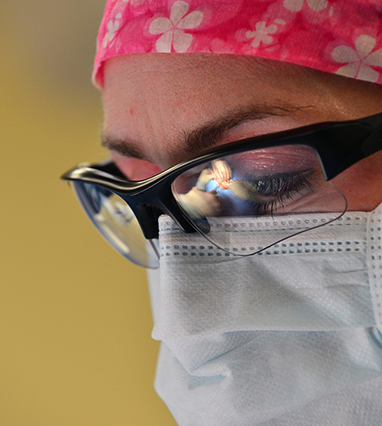Gall Bladder Surgery
Minimal access surgery
Gall Bladder surgery:
Surgery to remove the gallbladder (cholecystectomy) is the only way to treat gallstones. This can be done by conventional (open) method or a well established endoscopic (laparoscopic) method which is now the ‘Gold Standard’.
The surgery is called Laparoscopic Cholecystectomy (Lap. Chole).

For this operation, the surgeon makes few tiny incisions in the abdomen and inserts surgical instruments and a miniature telescope with a mounted video camera into the abdomen. The camera sends a magnified image from inside the body to a video monitor, giving the surgeon a close-up view of the organs and tissues. While watching the monitor, the surgeon uses the instruments to carefully separate the gallbladder from the liver, ducts and vessels. The gallbladder is then removed through one of the small incisions. Recovery usually occurs within a day in the hospital, followed by few days of rest at home.
Because the abdominal muscles are not cut during laparoscopic surgery, patients have less pain and fewer wound complications.
If the surgeon finds any difficulty in the laparoscopic procedure, the operating team may decide to switch over to open surgery. It is called ‘open’ surgery because the surgeon has to make a 5 to 8 inch incision in the abdomen to remove the gallbladder. Open surgery is now required in less than 0.1 percent gallbladder operations at our institute.
Post operative instructions and information
- After the operation you will be kept in the recovery room. This period may vary from few minutes to few hours. The anaesthetist decides about your shifting to room. The decision depends on many technical factors.
- You will be sleepy immediately after the operation due to sedation given during anaesthesia and during the recovery period.
- You may have some discomfort when coming out of the effect of sedation. It gradually reduces to a tolerable level within a few minutes without any pain killer. However, if necessary you may ask for pain killer injections/tablets. You should try to avoid these drugs because they produce drowsiness and you may sleep for a longer period which is not desirable.
- You may feel nauseated in the immediate post-operative period, and you may even vomit which should not cause any worry. This generally gets over after few hours.
- You are generally allowed to have sips of water immediately after the operation and liquids on day of operation. In case of vomiting the liquid intake may be stopped and restarted after 30 minutes. The liquids may include water / cold drinks / tea / coffee / milk / juices or some clear soups.
- You are allowed to have normal home cooked meals of your choice from the next morning at breakfast.
- You should have small frequent meals for few days after operation following which you can resume your normal diet gradually. This is vital because you may feel bloated and distended if the quantity of food is in large quantities at a time.
- You should try to move the limbs and can sit up immediately after operation. You should also go to the toilet on your own. There are no restrictions whatsoever for the physical movement. In fact majority of the patients will feel much better after they have started the movement. The pain also dramatically reduces once you start sitting up, moving and walking.
- There is no restriction on your physical activity. You are allowed to walk as soon as you recover from your sleep. There is no restriction on climbing of stairs, lifting weight etc. You may even drive two wheelers or car as soon as you feel fit. This infact is one of the major advantages of the laparoscopic procedure.
- You will be discharged on the same day or next day of operation unless there is some associated medical/social problems. You are advised to visit again for follow up after 2-5 days when the dressings are removed. You should avoid wetting the dressings unless they are waterproof. After the removal of dressing, you can have normal bath with soap and water.
- In very few cases there may be some bloody/whitish discharge from the wound in the post operative period. This should not bother you because it is generally harmless. You can wipe the discharge and apply band-aid so as to avoid staining the clothes. If it is more you should report to the surgeon during the next visit. Please feel free to ask any question that may come to your mind.
- We wish you a speedy recovery…
- This is not a substitute for medical advice.In case of a query, please contact your Doctor.
